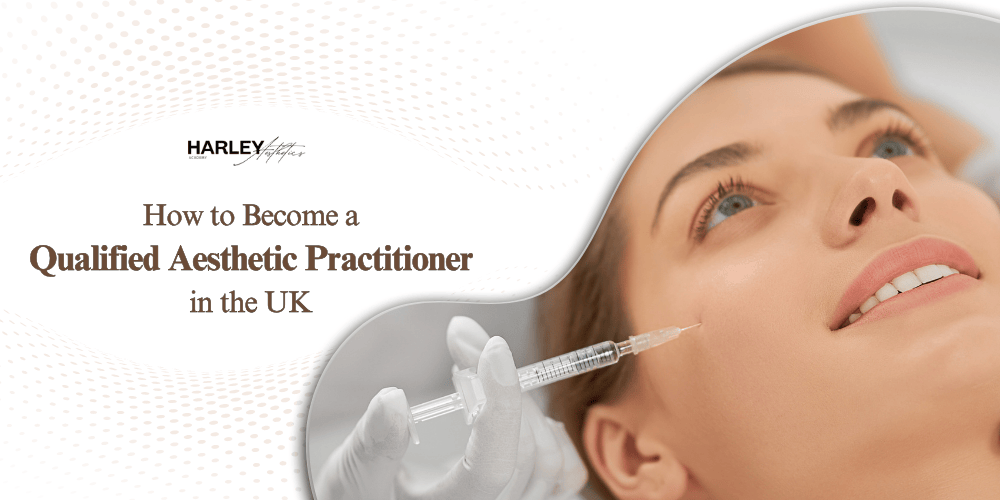June 2025 Sale – 40% Off Get Offers

The aesthetics industry in the UK is experiencing rapid growth, with more people than ever choosing non-surgical cosmetic treatments to enhance their appearance and confidence. Whether it’s lip fillers, anti-wrinkle injections, or skin boosters, the demand is growing – and so is the need for trained, ethical practitioners with knowledge in aesthetic courses as well as dermal filler course options.
But how exactly do you become a qualified aesthetic practitioner in the UK? If you’re starting with no medical background, or even if you’re a healthcare professional looking to transition into aesthetics, this guide is for you.
Let’s break it all down with honest answers to the most common questions people have before jumping into the world of injectables.
You might have found yourself asking:
Whether you’re coming from a beauty background, healthcare, or no experience at all, this guide is designed to give you real, practical advice on how to choose the best course, what you can expect, and how to navigate the exciting path ahead.
Let’s start with the basics—and what makes these training routes so appealing.
At its core, an aesthetic practitioner is someone who performs non-invasive cosmetic treatments, usually focusing on the face. These treatments include:
Being a qualified aesthetic practitioner means having the right training, insurance, and knowledge to perform these treatments safely and effectively.
But being successful in aesthetics is about more than just injecting, it’s about client care, consultation skills, business knowledge, and staying up-to-date with industry trends.
This is one of the most common questions asked by aspiring practitioners:
“Do I need to be a nurse or doctor to train in aesthetics?”
The answer? Not necessarily.
In the UK, many training providers accept non-medical applicants, especially if you have a background in beauty therapy (NVQ Level 3 or higher), semi-permanent makeup (SPMU), or skin therapy.
Of course, medical professionals like doctors, dentists, nurses, and pharmacists tend to progress faster in the field because they already understand facial anatomy, injection protocols, and clinical procedures.
But if you’re not from a medical background, don’t panic. You just need to take the right steps – starting with a quality training pathway.

Before injecting a single client, you’ll need proper training. This means choosing a recognised, insurable, and accredited course.
Many new practitioners start with aesthetic courses that combine foundation-level training in dermal fillers and anti-wrinkle injections. These are designed for beginners with no injecting experience.
The goal is not just to “get certified,” but to truly understand the science and safety behind these treatments.
Dermal fillers are one of the most in-demand treatments in the UK, especially for lips, cheeks, jawline, and under-eye areas. As a result, many people search for a “dermal filler course” as their starting point in aesthetics.
We highly recommend this dermal filler course if you’re serious about getting hands-on, practical training with full insurance eligibility. It’s designed specifically for beginners and covers not only injection techniques but also client communication and safety.
After all, dermal fillers aren’t just about beautifying lips. They involve precise anatomical knowledge to avoid serious complications and deliver natural results.
Here’s where things get a bit more nuanced.
In aesthetics, qualifications aren’t quite the same as traditional degrees. You’ll usually earn a Certificate of Completion or CPD-accredited certificate, which enables you to get insurance and start treating clients.
For more advanced roles (or in anticipation of future regulation), you can go on to earn:
But for most people starting out, a quality foundation aesthetic course and dermal filler course are enough to begin offering treatments, provided you also gain insurance.
Beyond training, here’s a checklist of things you’ll need to operate legally and professionally:
To get into aesthetic courses uk industry, you’ll need:
Some providers offer student insurance during your course.
Let’s talk about careers, because this is why most people enter aesthetics in the first place. Whether you’re eyeing a part-time income stream or a full business, the aesthetics field offers flexibility, high earnings, and control over your schedule.

With an intensive aesthetic course that combines online theory with live model training, you can technically begin treating clients in just 1–2 weeks after certification.
However, most beginners spend the first 1–3 months practising on friends, family, or offering discounted model rates to build confidence.
Success in aesthetics isn’t about rushing, it’s about building a reputation for safety and good results.
Once you’re confident with basic areas like lips, nasolabial folds, and marionette lines, you can consider more advanced training in:
Advanced courses typically require foundation-level certification and a portfolio of treatments.
Yes, when done right.
Many injectors transition to full-time within a year of starting, especially if they market themselves well and build trust through consistent results.
Here are a few practical methods that work:
The short answer: probably, yes.
The UK government has proposed a licensing scheme for aesthetic practitioners to improve safety and accountability. It hasn’t been finalised yet, but change is coming.
To future-proof yourself:
When regulation arrives, those who have done things properly will be in the best position to thrive.
Absolutely it is! If you care about helping people feel confident, enjoy learning hands-on skills, and want a flexible, high-earning career.
Starting with a reputable aesthetic course and a solid dermal filler course can launch you into an industry that’s growing year on year.
Yes, it takes work. Yes, you’ll make mistakes early on. But with the right mindset, support, and training, aesthetics can be an incredibly rewarding journey.
© Harley Aesthetics Copyright 2025. All Rights Reserved.
Social Chat is free, download and try it now here!